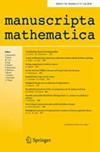Quasi-abelian group as automorphism group of Riemann surfaces
IF 0.6
4区 数学
Q3 MATHEMATICS
引用次数: 0
Abstract
Conformal/anticonformal actions of the quasi-abelian group \(QA_{n}\) of order \(2^n\), for \(n\ge 4\), on closed Riemann surfaces, pseudo-real Riemann surfaces and closed Klein surfaces are considered. We obtain several consequences, such as the solution of the minimum genus problem for the \(QA_n\)-actions, and for each of these actions, we study the topological rigidity action problem. In the case of pseudo-real Riemann surfaces, attention was typically restricted to group actions that admit anticonformal elements. In this paper, we consider two cases: either \(QA_n\) has anticonformal elements or only contains conformal elements.
作为黎曼曲面自变群的准阿贝尔群
对于 \(n\ge 4\), 我们考虑了阶为 \(2^n\) 的准阿贝尔群 \(QA_{n}\) 在封闭黎曼曲面、伪实黎曼曲面和封闭克莱因曲面上的共形/反共形作用。我们得到了一些结果,比如 \(QA_n\) 作用的最小属问题的解,而且对于每一种作用,我们都研究了拓扑刚度作用问题。在伪实黎曼曲面的情况下,人们的注意力通常局限于接纳反形式元素的群作用。在本文中,我们考虑了两种情况:要么 \(QA_n\) 有反形式元素,要么只包含共形元素。
本文章由计算机程序翻译,如有差异,请以英文原文为准。
求助全文
约1分钟内获得全文
求助全文
来源期刊

Manuscripta Mathematica
数学-数学
CiteScore
1.40
自引率
0.00%
发文量
86
审稿时长
6-12 weeks
期刊介绍:
manuscripta mathematica was founded in 1969 to provide a forum for the rapid communication of advances in mathematical research. Edited by an international board whose members represent a wide spectrum of research interests, manuscripta mathematica is now recognized as a leading source of information on the latest mathematical results.
 求助内容:
求助内容: 应助结果提醒方式:
应助结果提醒方式:


